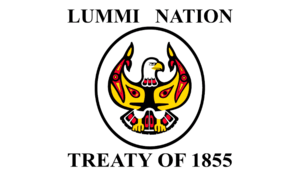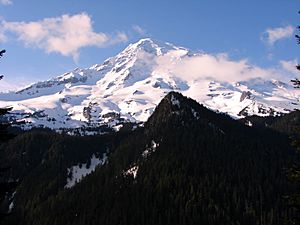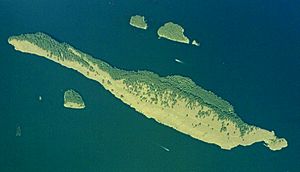Komo Kulshan and his two wives facts for kids
The story of Komo Kulshan and his two wives is a special tale from the Lummi people. It explains how important places in the Pacific Northwest were created. This includes famous landmarks like Mount Rainier, the Nooksack River, Spieden Island, and Mt. Baker. Each of these places is named after a character from the story. Their names come from the Lummi native language. Komo Kulshan means "white, shining mountain" or "great white watcher." His two wives are Duh-hwahk, meaning "clear sky," and Whaht-kway, meaning "fair maiden."
Contents
The Lummi People
The Lummi people (pronounced LUM-ee) are also known as Lhaq'temish, or "People of the Sea." They are a Native American tribe. The Lummi Nation lives along the northern coast of Washington State. Their home is in Whatcom County, near Puget Sound. For a long time, the Lummi people have moved between the sea and the mountains. They followed the seasons to find food and resources.
Duh-hwahk and Mount Rainier
The Lummi people tell that Duh-hwahk was Komo Kulshan's favorite wife. She was very beautiful and had three children with him. Komo Kulshan also had another wife, Whaht-kway. Whaht-kway was not as beautiful as Duh-hwahk. But she was much kinder and more charming.
Over time, Komo Kulshan grew to love Whaht-kway more. He liked her caring nature and gave her lots of attention. This made Duh-hwahk very jealous. She thought Komo Kulshan should love her more. After all, she was more beautiful and the mother of his children.
Duh-hwahk yelled at Komo Kulshan, but he only smiled. Angry, she threatened to leave him and their children. She thought he would beg her to stay. But he did not. Instead, he told her she could go as soon and as far as she pleased.
So Duh-hwahk slowly packed her belongings. She filled her bag with different plants, seeds, and roots. Her children wanted her to stay. This pleased her, as she was sure Komo Kulshan would change his mind. But he still did not.
When she left, she walked slowly through the mountain valleys. She thought Komo Kulshan would follow her, calling her back. But he did not. So she kept going. She climbed to the top of a hill. She waited for Komo Kulshan to call her back, but he did not.
She continued traveling among hills and mountains. They slowly grew taller. Soon, her family was out of sight. Standing on an even taller hill, she stretched on her tiptoes. She wanted to see them, but Komo Kulshan still did not call out.
By this time, she was sure Komo Kulshan did not want her back. She had also grown very tall from stretching to see her family. So, she made camp where she stood. She took care of the garden of plants, seeds, and roots she brought. She rested, knowing that on clear days, her family could see her. Duh-hwahk is now known as Mt. Rainier. People say the native plants growing there come from her garden.
Whaht-kway and the Nooksack River
Whaht-kway lived with Komo Kulshan for many years after Duh-hwahk left. She eventually became pregnant with a child. Whaht-kway really wanted to visit her mother. Her mother lived on an island in Whulge, which is now Puget Sound.
Komo Kulshan was worried. The island was far away. There was no clear path from their home to her mother's island. There were only mountains and trees. Whaht-kway was determined to see her mother. She told her husband he had to create a way for her to travel.
And so, he did. Komo Kulshan called on all the animals with digging paws. He asked them to dig a long, deep ditch. Bears, beavers, marmots, cougars, rats, moles, and mice all worked together. They easily dug a ditch all the way to the island.
After they finished, Komo Kulshan moved water from the mountains to fill the hole. This created a path. It was said to be wide enough for two canoes. Today, this river is called the Nooksack River.
Whaht-kway and Spieden Island
Whaht-kway filled her canoe with different types of food. She set off down the river. She eventually stopped at an island. There, she ate some of the mussels she brought. She left some behind before continuing her journey. She did the same on another island. She ate and left Camas plants there.
She repeated this on every island she passed. She left every type of food she brought with her. Now, each of the islands she visited is named after the type of food she left behind. Finally, Whaht-kway reached an island called Flat Top Island in Whulge. She stayed there, lying down. She became what is known today as Spieden Island. When her child was born, it became a smaller island. It has a similar shape and is known today as Sentinel Island.
Komo Kulshan and Mount Baker
Sometime later, Komo Kulshan began to miss his wives. So he decided to pack his things with his children. He left so he could be closer to both Whaht-kway and Duh-hwahk. He stretched himself so he could see them. Komo Kulshan became almost as tall as Duh-hwahk. He is now known as Mount Baker. His children copied their father. They also grew up to the sky. They are said to have become what is known as Twin Sisters Mountain.




